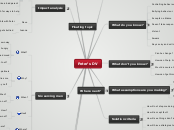Floating topic
Where next?
You can continue to develop this map without the Smart Map wizard by saving it as a normal Mindomo map.
When have a comprehensive description of the problem, you can move towards finding solutions. Consider a brainstorm as a next step, using the Brainstorming Toolbox Smart Map.
You can delete this topic from the saved map.
Where next?
You can continue to develop this map without the Smart Map wizard by saving it as a normal Mindomo map.
When have a comprehensive description of the problem, you can move towards finding solutions. Consider a brainstorm as a next step, using the Brainstorming Toolbox Smart Map.
Peter's DV
Name the problem
Identify the problem or issue in a few words and press Enter. This will become the title of your map.
Be the problem
Be the problem is a popular technique for understanding problems. It means developing a character for the problem and describing its nature as if it were a person.
Be the problem
'Be the problem' is a popular technique for understanding problems. It means developing a character for the problem and describing its nature as if it were a person.
Insight
Add an insight
Add a statement describing the problem as if it were a person.
- What does the world look like from the problem's perspective?
- How does it respond in certain situations?
- What does it like or not like?
- What weaknesses does it look for in people or situations?
- What weaknesses does it have that make it vulnerable?
- What strengths does it have that make it 'successful'?
- Does it 'get lucky' sometimes?
- How does it help other people and support their goals?
Analogies
Can you find analogies for this problem?
The underlying characteristics of a problem can sometimes be clearer when it is taken out of context.
Analogies
Can you find analogies for this problem?
The underlying characteristics of a problem can sometimes be clearer when it is taken out of context.
What is it like?
What is 'Peter's DV' like?
Is 'Peter's DV' like anything else?
- Have similar problems or similar causes been seen in other places?
- What would it look like if you imagined the same problem in a completely different situation? For example, how would the problem behave at a wedding, at a concert, in a supermarket, or underwater?
Six serving men
"Six Serving Men" is based on Rudyard Kipling's poem, which begins:
''I keep six honest serving men
(They taught me all I knew);
Their names are What and Why and When
And How and Where and Who.''
We can profile a problem and perhaps discover more about it by asking structured questions.
Six Serving Men
'Six Serving Men' is based on Rudyard Kipling's poem, which begins:
I keep six honest serving men
(They taught me all I knew);
Their names are What and Why and When
And How and Where and Who.
We can profile a problem and perhaps discover more about it by asking structured questions.
Who?
Who not?
Who does not cause 'Peter's DV'?
- Are there people or users who manage to avoid this problem?
- Are they doing something different to everyone else?
Who causes 'Peter's DV'?
- Is there any connection with certain people or users?
- Are they doing something different to everyone else?
Where?
Where not?
Where does 'Peter's DV' not happen?
- Are there locations or places where the problem does not happen?
- Are there locations where it should happen but doesn't?
Where does 'Peter's DV' happen?
- Is there any connection with locations or places?
How?
How not?
How does 'Peter's DV' not happen?
- How do you know when the problem is not happening?
- Could the problem actually not be happening, when you think it is?
- Is it really there all the time?
How does 'Peter's DV' happen?
- How does the problem appear?
- How do you know the problems is happening?
- Could it be happening when you are not aware of it?
When?
When not?
When does 'Peter's DV' not happen?
- Are there times when this problem does not happen?
- Are there times when according to theory, it should happen, but doesn't?
- If it is intermittent, when does it start working again?
When does 'Peter's DV' happen?
- Is there any connection with dates, times or other events?
- Is it something that was working once, and has stopped working?
Why?
Why not?
Why is 'Peter's DV' not a problem?
- Are there times when this situation occurs, but it is not a problem?
He bullies me
He may use DV with future partners
Why is 'Peter's DV' a problem?
What?
What not?
When he's in a good mood
What does not cause 'Peter's DV'?
- What does not trigger this problem?
- Are there situations or conditions that might be expected to cause it, but don't?
When he's in a bad mood
When he's hungry
When he doesn't get his own way
What causes 'Peter's DV'?
- What causes or triggers this problem?
- Are there situations or conditions that are not expected to cause it, but do somehow?
Impact analysis
Impact analysis looks at who is affected by the problem - what the consequences are, rather than the causes.
Impact analysis
Impact analysis looks at who is affected by the problem - what the consequences are, rather than the causes.
Joanna
She gets bullied
What is the impact?
How is Joanna affected by 'Peter's DV'?
- What are the symptoms?
- What do they have to do when encountering the problem?
- Could they provide more information?
- Could they try doing things in a different way?
Rate the impact by clicking an icon:
High impact - significant consequences
Medium impact - annoying but tolerable
Low impact - negligible effect
Dave
He fights with Peter
What is the impact?
How is Dave affected by 'Peter's DV'?
- What are the symptoms?
- What do they have to do when encountering the problem?
- Could they provide more information?
- Could they try doing things in a different way?
Rate the impact by clicking an icon:
High impact - significant consequences
Medium impact - annoying but tolerable
Low impact - negligible effect
Me
Who is affected?
Type in a name or role of someone who is affected by 'Peter's DV'
It makes me search for ways to help
I feel like a bad parent
It makes me not like him
He scares me
What is the impact?
How is Me affected by 'Peter's DV'?
- What are the symptoms?
- What do they have to do when encountering the problem?
- Could they provide more information?
- Could they try doing things in a different way?
Rate the impact by clicking an icon:
High impact - significant consequences
Medium impact - annoying but tolerable
Low impact - negligible effect
Root cause analysis
For analytical problems, root cause analysis can help to unravel indirect causes of problems, leading to more effective solutions. One way to do this is to keep asking "Why?" down to five levels, to understand the reasons behind the reasons.
Root Cause analysis
For analytical problems, root cause analysis can help to unravel indirect causes of problems, leading to more effective solutions. One way to do this is to keep asking 'Why?' down to five levels, to understand the reasons behind the reasons.
He thinks it's all about him
Why does 'Peter's DV' happen?
Enter a reason that 'Peter's DV' happens.
I've let him away with too much
Because I don't want him sad
Why does 'I've let him away with too much' happen?
Enter a reason that 'I've let him away with too much' happens.
(Level 3 of 5)
Because I love him so much
Why does 'Because I don't want him sad' happen?
Enter a reason that 'Because I don't want him sad' happens.
(Level 4 of 5)
Why does 'Because I love him so much' happen?
Enter a reason that 'Because I love him so much' happens.
(Level 5 of 5)
Subtopic
His ASD
Why does 'He thinks it's all about him' happen?
Enter a reason that 'He thinks it's all about him' happens.
(Level 2 of 5)
Cause
Why does 'His ASD' happen?
Enter a reason that 'His ASD' happens.
(Level 3 of 5)
Why does 'Cause' happen?
Enter a reason that 'Cause' happens.
(Level 4 of 5)
Why does 'Cause' happen?
Enter a reason that 'Cause' happens.
(Level 5 of 5)
Solution criteria
How will you know when you have solved the problem?
* What will a successful resolution look like?
* How will you filter and assess potential solutions?
* How will you verify that the issue has been solved?
You might want to return to the solution criteria several times as you develop the definition of the problem.
Solution criteria
How will you know when you have solved 'Peter's DV'?
- What will a successful resolution look like?
- How will you filter and assess potential solutions?
- How will you verify that the issue has been solved?
You might want to return to the solution criteria several times as you develop the definition of the problem.
He will treat me with respect
He will have strategies to solve problems
He will see things don't always go his way
He will accept fault
He will not stop me doing things
Add solution criterion
Add a solution criterion. Make sure you consider:
- Minimum acceptable success criteria
- Meeting constraints on solutions, e.g. cost, time, resources
- Ensuring that the symptoms will disappear
- Resolving the impact on various users
- Addressing the root causes
- Validating the solution against known data
What assumptions are you making?
In identifying the problem and the probability of a solution, what assumptions are you making?
Assumptions can sometimes be hard to see or accept. For example, if the "problem" is that sales of a certain product are too low, you may naturally aim to increase sales. You are ''assuming'' that the market demand for this product will continue. But if the demand disappeared overnight in a storm of negative publicity, then the original problem and solution also change. So the problem and logical solution are partly based on an assumption.
What assumptions are you making?
In identifying the problem and the probability of a solution, what assumptions are you making?
Assumptions can sometimes be hard to see or accept. For example, if the 'problem' is that sales of a certain product are too low, you may naturally aim to increase sales. You are assuming that the market demand for this product will continue. But if the demand disappeared overnight in a storm of negative publicity, then the original problem and solution also change. So the problem and logical solution are partly based on an assumption.
That it is partly my fault
That he is in danger of perpetrating DV
That he can change
Add an assumption
Identify an assumption you are making in both the description of the problem and the logical solution.
- What would happen if the assumption changed?
- What if the assumption is not valid?
- Might different assumptions also apply?
What don't you know?
What other information might help, but is not available today?
* How would it help?
* How could you obtain it?
* Can you work without it?
* What are the risks or consequences of not knowing?
* Who else might have further information and insight?
What don't you know?
What other information might help, but is not available today?
- How would it help?
- How could you obtain it?
- Can you work without it?
- What are the risks or consequences of not knowing?
- Who else might have further information and insight?
How can I get him to go to a course?
Would a course help?
How can I help him?
Can he change?
Add an unknown factor
Identify information or data that is not known or not reliable, and what you can do to find it. Think about:
- Missing information
- Information that could be unreliable
- Information from reliable sources that is factually wrong
- Other people who might have useful information or experience
What do you know?
Factual data about the problem
What do you know?
What factual data do you already have about 'Peter's DV'?
Says sorry and will never do it again
Swears
Violent
Doesn't take responsibility
Accepts no blame
Bullying behaviour
Controlling behaviour
Add a piece of data
Add an item of data or a reference to it. Think about:
- Measurements and samples
- Statistics and trends
- Surveys
- Symptoms, documented evidence and verbal stories
- Possibly related incidents or symptoms
Problem type
Whether this is mainly a creative or analytical problem
What type of problem is this?
Is 'Peter's DV' a creative issue or an analytical one?
- Do you need an inventive or innovative solution, to create something that does not exist today?
- Do you need to change something and do it in a different way?
- Do you need to diagnose and fix something that is broken?
Change something
Describe the problem type
Select the problem type or enter your own description.
Create something newChange somethingFix something broken









